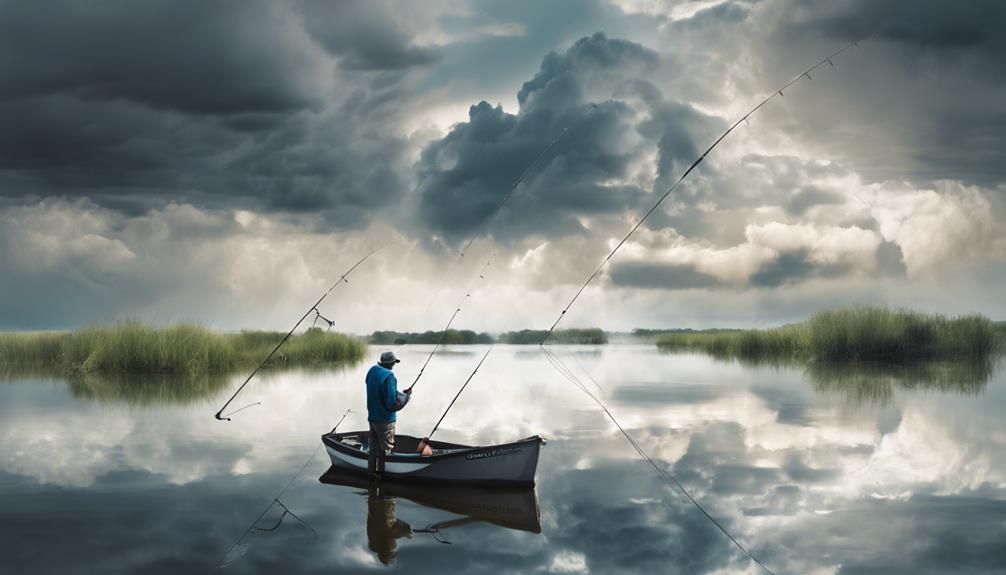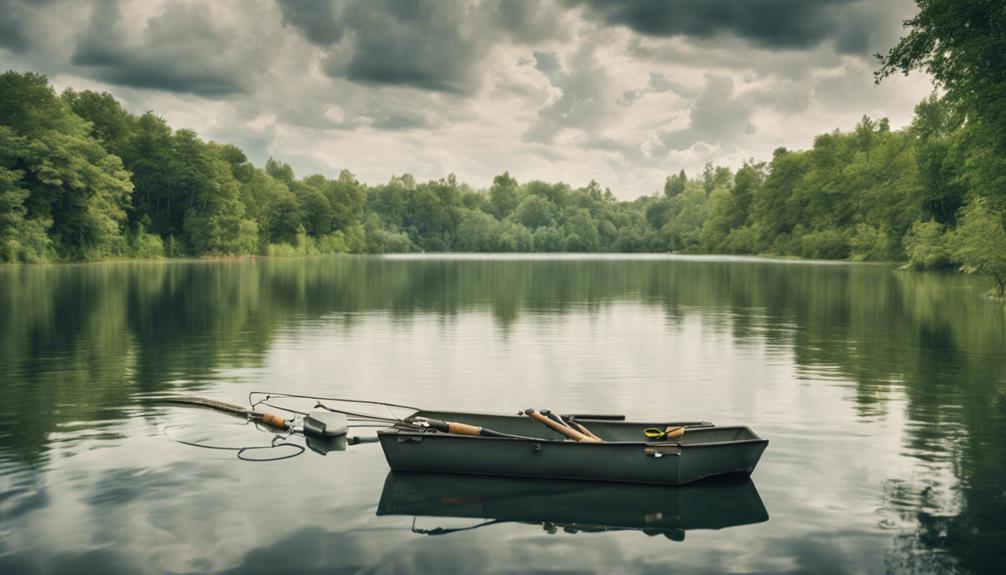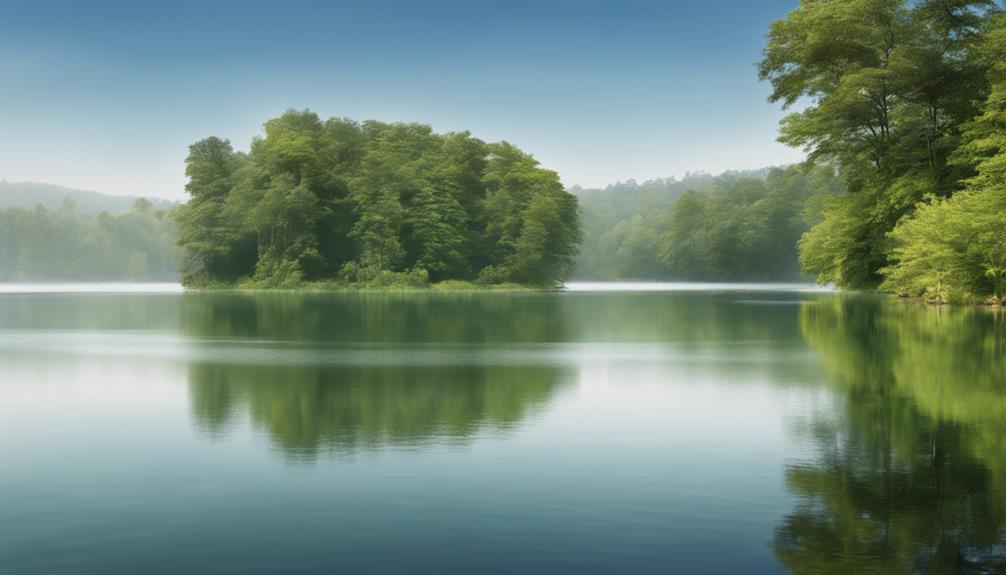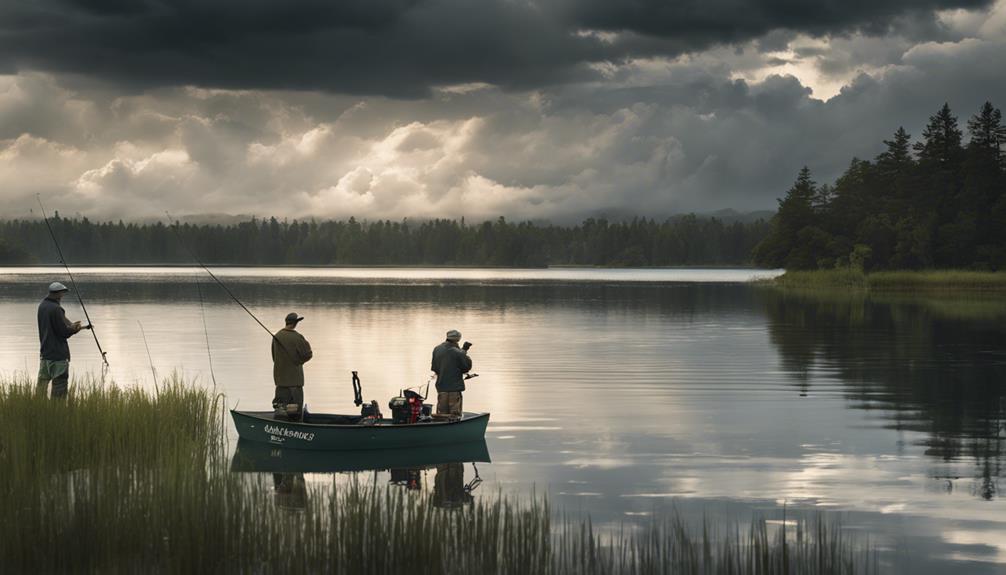Understanding cloud cover is crucial for fishing success. Different cloud types impact fish behavior and habitat choices. Opt for cumulus clouds for fair conditions, while altocumulus clouds signal unsettled weather. Adjust casting techniques based on cloud cover for optimal results. Cloud cover affects light penetration into water, influencing fish depth and feeding habits. Adapt lure choices and retrieval speed according to visibility. Reading cloud patterns reveals changing weather and aids in strategic positioning. Cloud cover acts as natural camouflage, enhancing angling strategy. Monitoring cloud cover helps plan fishing trips effectively. Mastering cloud nuances can elevate your angling game significantly.
Importance of Cloud Cover
Cloud cover plays a crucial role in determining fishing success by influencing fish behavior and habitat preferences. Understanding cloud formation and weather patterns is essential for anglers seeking to optimize their fishing outings. Clouds are formed through the condensation of water vapor in the atmosphere, leading to the creation of various cloud types that can impact fishing conditions. Different weather patterns can result in specific cloud formations, each with its own implications for fishing activities.
Cloud cover affects fishing success by regulating light levels and water temperature. On bright, sunny days with minimal cloud cover, fish tend to seek shelter in deeper waters or under structures to avoid the intense sunlight. Conversely, on overcast days with thick cloud cover, fish may venture closer to the surface to feed, making them more accessible to anglers. Understanding these behavioral patterns can significantly increase the chances of a successful fishing trip.
Moreover, cloud cover can influence the distribution of fish species in a body of water. Certain species prefer specific light conditions, which are often dictated by the presence or absence of clouds. By paying attention to cloud cover and the resulting light penetration in the water, anglers can strategically target areas where their desired fish species are likely to be found.
Types of Clouds for Fishing
Optimal fishing conditions are often associated with specific cloud formations that impact fish behavior and habitat preferences. Cloud identification plays a crucial role in determining the ideal conditions for successful fishing trips. Different types of clouds can affect fish activity in various ways.
Cumulus clouds, characterized by their fluffy, cauliflower-like appearance, often indicate fair weather. These clouds typically bring moderate winds and scattered showers, making them favorable for fishing. However, when cumulus clouds start to build vertically, they can develop into cumulonimbus clouds, which signal potential thunderstorms and heavy rain, prompting fish to seek shelter.
Stratocumulus clouds, forming low, thick layers with a somewhat uniform appearance, are associated with stable weather conditions. Fish tend to be less active under these clouds, as they often indicate prolonged periods of overcast skies and light precipitation.
For cloud photography enthusiasts, capturing the beauty of altocumulus clouds can be rewarding. These mid-level clouds appear as small, white patches often grouped together in a regular pattern. Altocumulus clouds suggest unsettled weather, with the possibility of light rain showers. Fish behavior under altocumulus clouds can vary, but they generally remain active unless the weather deteriorates rapidly.
Understanding cloud types and their implications on fishing can significantly enhance your angling experience. By observing cloud formations and their associated weather patterns, you can adapt your fishing strategies to maximize success on the water.
Optimal Cloud Cover for Casting
With the right cloud cover, your casting accuracy and success rate can significantly improve. Cloud cover plays a crucial role in determining the optimal conditions for casting during fishing trips. Understanding how different types of cloud cover affect your casting accuracy can help you make the most out of your fishing experience.
Here are some key points to consider:
- Casting Accuracy: The right amount of cloud cover can provide a diffused light that reduces glare off the water, making it easier for you to see your target and cast accurately. Too much sunlight can create harsh reflections, making it challenging to gauge distances and angles accurately.
- Cloud Cover Variability: Cloud cover isn't static and can change throughout the day. Pay attention to cloud movements and patterns to anticipate changes in lighting conditions. Adjust your casting technique accordingly to maintain optimal accuracy as cloud cover shifts.
- Fishing Productivity: Optimal cloud cover can also impact overall fishing productivity. Cloud cover can influence fish behavior and feeding patterns, which in turn affects your casting success. Understanding the relationship between cloud cover and fishing productivity can help you strategize your casting approach for better results.
Cloud Cover and Fish Behavior
Considering the impact of cloud cover on casting accuracy, understanding how cloud cover influences fish behavior is crucial for optimizing fishing success. Weather patterns play a significant role in dictating fish behavior. Fish are sensitive to changes in atmospheric conditions, and cloud cover can directly affect their activity levels.
Cloud cover affects fish behavior by altering the amount of light that penetrates the water. On bright, sunny days, with minimal cloud cover, light can penetrate deeper into the water, leading fish to seek shelter in deeper or shaded areas. Conversely, on overcast days with heavy cloud cover, light intensity decreases, prompting fish to move into shallower waters or venture out into open areas to feed.
Anglers should adjust their strategies based on the prevailing cloud cover conditions. During periods of heavy cloud cover, when fish are more likely to be actively feeding in shallower waters, anglers may find success using topwater lures or surface baits. On the other hand, in bright conditions with minimal cloud cover, fish may be more lethargic and seek deeper, cooler waters, requiring anglers to use sinking baits or fish at greater depths.
Adjusting Techniques in Overcast Conditions
Adjust your fishing techniques in overcast conditions to maximize your chances of success by capitalizing on the behavior changes of fish influenced by diminished light penetration. When the sky is overcast, fish tend to move closer to the surface and become more active. To make the most of these conditions, consider the following:
- Tackle Selection: Opt for lures or bait that create more vibration or movement to attract fish in low light situations. Brightly colored lures can also be effective as they stand out more against the grey backdrop of an overcast sky, increasing visibility for the fish.
- Bait Presentation: Adjust your retrieval speed to a slower pace as fish may be more lethargic in overcast conditions. Additionally, try using scent-enhanced baits to compensate for reduced visibility. Fish rely more on their sense of smell when visibility is limited, making scented baits a strategic choice.
- Stay Flexible: Overcast conditions can change rapidly, so be prepared to adapt your techniques as needed. Keep a variety of tackle options at hand to switch between different lures or baits until you find what works best on that particular day.
Cloud Cover's Influence on Water Temperature
Cloud cover directly impacts water temperature by moderating the amount of sunlight that reaches the surface of the water. The extent of this influence is determined by factors such as water clarity and the intensity of solar radiation. Cloud cover can act as a barrier, reducing the penetration of sunlight into the water. This, in turn, can lead to a decrease in water temperature due to less solar energy being absorbed.
In clearer waters, where sunlight can penetrate deeper, cloud cover may have a less pronounced effect on water temperature compared to cloudy conditions in turbid waters. The interaction between cloud cover and water clarity is crucial in understanding how temperature variations occur in different fishing spots.
When fishing in areas with varying degrees of cloud cover, anglers need to consider how these conditions affect water temperature. Cooler water temperatures can impact fish behavior, influencing their feeding patterns and movements. To adapt to these changes, anglers may need to adjust their fishing techniques accordingly.
Reading Cloud Patterns for Success

Understanding cloud patterns is essential for predicting fishing success based on environmental conditions. Interpreting formations and strategically positioning yourself can significantly improve your chances of a successful fishing trip. Here are some key points to consider:
- Cloud Movement: Observing the direction and speed of cloud movement can give you insights into changing weather patterns. It can help you anticipate potential shifts in wind direction or upcoming rain, allowing you to adjust your fishing strategy accordingly.
- Cloud Density: The density of clouds can affect the amount of sunlight reaching the water's surface. Thicker cloud cover may reduce visibility for both fish and anglers, leading to different feeding behaviors. Understanding how cloud density impacts light penetration can guide your choice of bait and fishing depth.
- Cloud Color: The color of clouds can indicate the time of day or the likelihood of precipitation. Dark, ominous clouds may signal an approaching storm, prompting you to seek shelter or adjust your fishing location. Lighter, fluffy clouds often accompany fair weather conditions, providing optimal opportunities for fishing.
Using Clouds as Natural Camouflage
Utilize cloud cover effectively as a natural form of concealment when positioning yourself for optimal fishing opportunities. Cloud concealment can provide anglers with a significant angling advantage by masking their presence from cautious fish. When strategically using cloud cover as weather camouflage, anglers can enhance their fishing strategy and increase their chances of success.
Cloud concealment plays a crucial role in creating a stealthy approach to fishing. By blending into the natural surroundings and avoiding detection, anglers can get closer to their target without spooking the fish. This is especially beneficial when fishing in clear or shallow waters where visibility is high, making it easier for fish to spot any unnatural movements.
To maximize the angling advantage that cloud concealment offers, anglers should pay close attention to cloud patterns and movements. Position yourself in a way that takes advantage of the cloud cover, using it to shield your presence and movements from the fish below. By adapting your fishing strategy to incorporate cloud camouflage, you can effectively increase your chances of a successful catch.
Cloud Cover's Impact on Fish Feeding
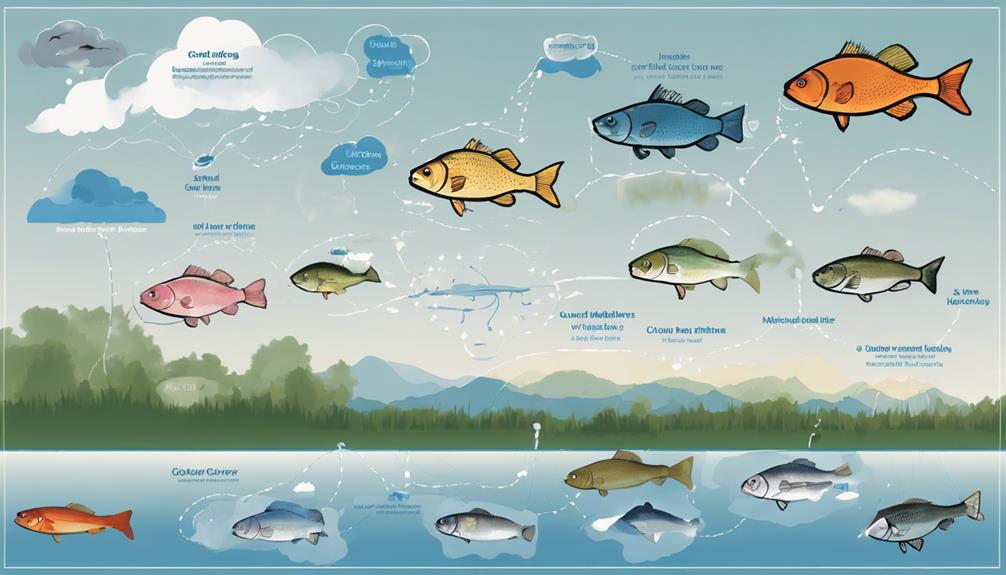
Blending into your natural surroundings by leveraging cloud cover as a form of camouflage can significantly impact the feeding behavior of fish. When considering cloud cover's influence on fish feeding, it's crucial to understand how fishing patterns and weather conditions play a role. Here are some key points to keep in mind:
- Reduced Visibility: Thick cloud cover can decrease the amount of sunlight penetrating the water, making it harder for fish to see potential prey. This can lead to a decrease in fish feeding activity as they rely heavily on their vision to hunt.
- Changes in Water Temperature: Cloud cover can affect the water temperature by blocking out the sun's heat. This shift in temperature may alter the metabolism of fish, affecting their feeding habits. Some fish species may become less active in cooler water, impacting their willingness to feed.
- Altered Feeding Times: Different cloud cover densities can impact the amount of light available for fish to feed. This can result in changes to the feeding times of certain fish species, as they may prefer to feed during low light conditions caused by thick cloud cover.
Understanding how cloud cover influences fish feeding behavior based on fishing patterns and weather conditions can help you adapt your fishing strategies for optimal success.
Planning Your Fishing Trips Based on Cloud Cover
When planning your fishing trips, consider the impact of cloud cover on fish behavior to maximize your success. Weather patterns play a crucial role in determining the level of cloud cover you may encounter during your fishing expedition. Understanding how cloud cover influences fish activity can significantly enhance your angler strategy and increase your chances of a fruitful day out on the water.
Different weather patterns can result in varying degrees of cloud cover over your favorite fishing spots. Cloud cover affects the amount of sunlight penetrating the water, which in turn impacts the visibility of prey for the fish. On bright, sunny days with minimal cloud cover, fish tend to seek shelter in deeper waters or under structures to avoid direct sunlight. Conversely, on cloudy days, fish are more likely to venture out into shallower areas to feed since the diffused light provides them with a sense of security.
To plan your fishing trips effectively based on cloud cover, monitor weather forecasts to anticipate cloud patterns over your chosen fishing spots. Consider scheduling your trips during periods of moderate cloud cover, as this can stimulate fish activity and improve your chances of a successful catch. By aligning your angler strategy with cloud cover conditions, you can adapt your techniques accordingly and increase your overall fishing success rate.
Frequently Asked Questions
How Does Pollution Affect Cloud Cover When Fishing?
When fishing, pollution can impact cloud cover by contributing to the formation of smog or haze, which can obscure sunlight.
This reduced sunlight affects the natural cloud formation process, potentially leading to less cloud cover.
When faced with diminished cloud cover, consider adjusting your fishing techniques by incorporating artificial lighting to attract fish that may be less active due to the altered lighting conditions caused by pollution.
Can Artificial Lighting Mimic Natural Cloud Cover for Fishing?
Artificial lighting can mimic natural cloud cover for fishing by providing a similar level of diffusion and shadowing effects. Light sources can be strategically placed to simulate cloud patterns, helping create an atmosphere conducive to angler perception.
How Do Different Fish Species React to Varying Cloud Types?
Different fish species react differently to varying cloud types based on their behavior and the corresponding weather patterns. Some species may become more active and feed closer to the surface under certain cloud cover conditions, while others might prefer deeper waters or sheltered areas.
Understanding these nuances can help you adapt your fishing techniques and strategies to maximize your success based on the specific behavior patterns exhibited by different fish species in relation to cloud cover.
Does Cloud Cover Impact the Effectiveness of Fishing Lures?
When it comes to cloud cover and fishing lure effectiveness, weather patterns play a crucial role.
Cloud cover impacts angler visibility and can affect how fish respond to bait selection. Cloudy days may require different lure colors or sizes compared to sunny days.
Understanding how cloud cover influences fish behavior can help you adjust your fishing tactics accordingly for better success on the water.
Is There a Correlation Between Cloud Cover and Fishing Spot Popularity?
When considering the correlation between cloud cover and fishing spot popularity, weather patterns play a crucial role in angler preferences. Cloud cover can impact fishing pressure and the choice of fishing spots.
Anglers often gravitate towards certain locations based on weather conditions. Understanding how cloud cover influences fishing spot popularity can provide insights into angler behavior and help optimize fishing strategies for different weather scenarios.
Conclusion
In conclusion, understanding the impact of cloud cover on fishing success is crucial for maximizing your catch rate.
By recognizing the optimal cloud conditions, adjusting your techniques accordingly, and planning your trips based on cloud patterns, you can significantly increase your chances of a successful fishing outing.
Cloud cover not only affects fish behavior and feeding patterns but also provides natural camouflage, making it a key factor to consider when heading out to the water.
